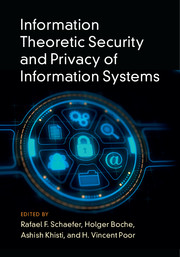Book contents
- Frontmatter
- Contents
- List of Contributors
- Preface
- Part I Theoretical Foundations
- Part II Secure Communication
- 5 Secrecy Rate Maximization in Gaussian MIMO Wiretap Channels
- 6 MIMO Wiretap Channels
- 7 MISO Wiretap Channel with Strictly Causal CSI: A Topological Viewpoint
- 8 Physical-Layer Security with Delayed, Hybrid, and Alternating Channel State Knowledge
- 9 Stochastic Orders, Alignments, and Ergodic Secrecy Capacity
- 10 The Discrete Memoryless Arbitrarily Varying Wiretap Channel
- 11 Super-Activation as a Unique Feature of Secure Communication over Arbitrarily Varying Channels
- Part III Secret Key Generation and Authentication
- Part IV Data Systems and Related Applications
- Index
- References
9 - Stochastic Orders, Alignments, and Ergodic Secrecy Capacity
from Part II - Secure Communication
Published online by Cambridge University Press: 28 June 2017
- Frontmatter
- Contents
- List of Contributors
- Preface
- Part I Theoretical Foundations
- Part II Secure Communication
- 5 Secrecy Rate Maximization in Gaussian MIMO Wiretap Channels
- 6 MIMO Wiretap Channels
- 7 MISO Wiretap Channel with Strictly Causal CSI: A Topological Viewpoint
- 8 Physical-Layer Security with Delayed, Hybrid, and Alternating Channel State Knowledge
- 9 Stochastic Orders, Alignments, and Ergodic Secrecy Capacity
- 10 The Discrete Memoryless Arbitrarily Varying Wiretap Channel
- 11 Super-Activation as a Unique Feature of Secure Communication over Arbitrarily Varying Channels
- Part III Secret Key Generation and Authentication
- Part IV Data Systems and Related Applications
- Index
- References
Summary
We investigate the relation between different stochastic orders and the degradedness of a fast fading wiretap channel with statistical channel state information at the transmitter (CSIT). In particular, we derive sufficient conditions to identify the ergodic secrecy capacities for both single and multiple antenna cases even though there is only statistical CSIT.
Introduction
To design a wiretap code with higher secrecy rate, channel state information at the transmitter of the legitimate and eavesdropper's channels1 should be known to a certain degree. When there is perfect CSIT of both channels, the secrecy capacity of a Gaussian wiretap channel can be achieved by a Gaussian input. However, due to several practical issues such as (1) being a malicious user, Eve is by no means intending to feed back the correct CSI to Alice; (2) limited feedback bandwidth; (3) the delay caused by channel estimation; (4) the speed of channel variation, etc., it is more reasonable to consider cases where perfect CSIT is unavailable.
In this chapter we consider the cases when only statistical CSIT of both channels from Alice to Bob and Alice to Eve, respectively, are available. One possible way to get such information from Eve virtually is as follows. For some bounded space like indoor parking lots or malls, it is possible to collect the channel statistics offline of most of the positions within that space, where the channel variation may be due to the movement of people or cars, etc. When Alice wants to transmit, she can use the known statistics measured offline of the channel between her and the unknown user closest to her as Eve's channel information to design her wiretap code for the worst-case scenario.
Although the secrecy capacity formula for discrete memoryless non-degraded wiretap channels was proved in [1], the optimal selection of the auxiliary random variable and channel prefixing are still unknown for additive white Gaussian noise (AWGN) channels with partial CSIT in general. Only a few capacity results under the considered scenario are known, and are summarized as follows.
- Type
- Chapter
- Information
- Publisher: Cambridge University PressPrint publication year: 2017
References
- 1
- Cited by

